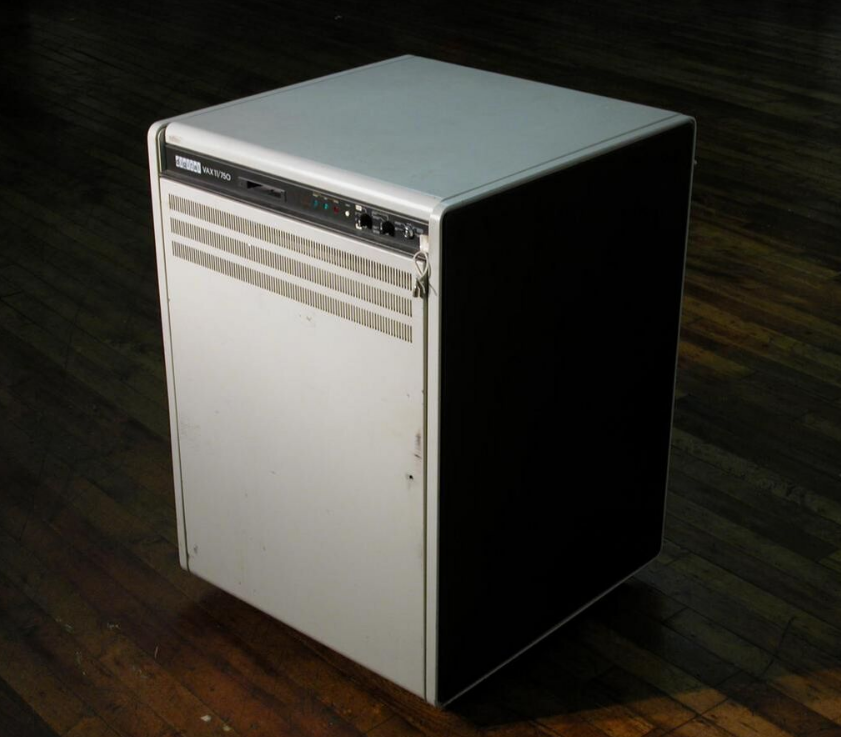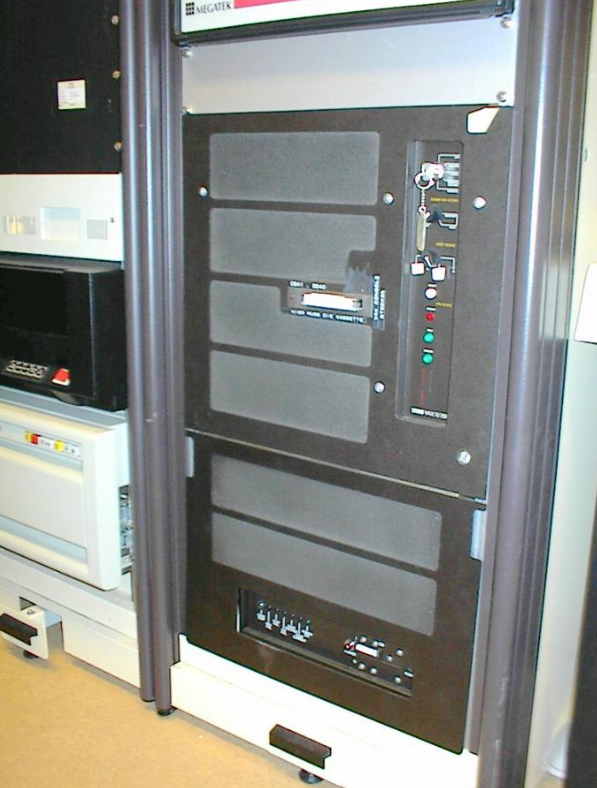The VAX-11 is a discontinued family of superminicomputers developed and manufactured by Digital Equipment Corporation (DEC). They were first announced in 1977, and were the first computers to implement the Virtual Address eXtension (VAX) instruction set architecture (ISA). The VAX-11 processors also supported the user mode PDP-11 instruction set for backwards compatibility (thus the -11 in VAX-11). They were discontinued in 1988, having been supplanted by the MicroVAX family on the low end, and the VAX 8000 family on the high end. It is historically one of the most successful and studied computers in history.
- vax-11
- superminicomputers
- pdp-11
1. VAX-11/780
The VAX-11/780, code-named "Star", was introduced on 25 October 1977 at DEC's Annual Meeting of Shareholders.[1] It is the first computer to implement the VAX architecture. The KA780 central processing unit (CPU) is built from Schottky transistor-transistor logic (TTL) devices and has a 200 ns cycle time (5 MHz) and a 2 kB cache. Memory and I/O are accessed via the Synchronous Backplane Interconnect (SBI).
The VAX-11/780 originally supported up to 8MB of memory through one or two MS780-C memory controllers, with each controller supporting between 128kB-4MB of memory. The later MS780-E memory controller supported 4MB-64MB of memory, allowing the VAX-11/780 to support up to a total of 128MB of memory.[2] The KA780 has a 29-bit physical address space, allowing it to address a theoretical maximum of 512MB of memory. The memory is constructed from 4 or 16 kbit metal oxide semiconductor (MOS) RAM chips mounted on memory array cards. Each memory controller controls up to 16 array cards. The memory is protected by error correcting code (ECC).[3]
The VAX-11/780 uses the Unibus and Massbus for I/O. Unibus is used for attaching lower-speed peripherals such as terminals and printers and Massbus for higher-speed disk and tape drives. Both buses are provided by adapters that interface the bus to the SBI. All systems come with one Unibus as standard, with up to four supported. Massbus is optional, with up to four supported.[4] The VAX-11/780 also supports Computer Interconnect (CI), a proprietary network to attach disk drives and potentially share them with other VAX computers. Later, this feature was used to connect VAX computers in a VMScluster.
Digital used the performance of the VAX-11/780 as a reference point for describing the performance of subsequent VAX models. The performance of the VAX-11/780 became known as 1 VAX Unit of Performance (or 1.0 VUPs).[5] Other VAX models were rated as a multiple of the VAX-11/780's performance, for example, a 2.0 VUPs VAX would be twice as fast as the VAX-11/780.
1.1. VAX-11/782
The VAX-11/782, code-named "Atlas",[6] is a dual-processor VAX-11/780 introduced in 1982. Both processors share the same MA780 multiport memory bus and the system operates asymmetrically, with the primary CPU performing all I/O operations and process scheduling with the second, attached processor only used for additional computationally-intensive work. For multistream computation-intensive tasks the system delivers up to 1.8 times the performance of a VAX 11/780.[5][7]
1.2. VAX-11/784
The VAX-11/784, code-named "VAXimus",[6] is a rare quad-processor variant of the VAX-11/780. Similar to the VAX-11/782, it was an asymmetric multiprocessing system, with all four KA780 processors sharing the same MA780 multiport memory bus. Its performance was rated as 3.5 VUPs.[5]
1.3. VAX-11/785
The VAX-11/785, code-named "Superstar", was introduced in April 1984.[8] Its KA785 CPU is essentially a faster KA780, with a CPU cycle time of 133 ns (7.52 MHz) versus the 200 ns (5 MHz) CPU cycle time of the KA780,[9] giving a performance of 1.5 VUPs.[5][10] The decrease in CPU cycle time was accomplished through use of Fairchild Advanced Schottky TTL (FAST) logic.[11]
1.4. VAX-11/787
The VAX-11/787 is a possible dual-processor variant of the VAX-11/785. It is unclear whether any were produced.[6]
2. VAX-11/750

The VAX-11/750, code-named "Comet", is a more compact, lower-performance Bipolar gate array–based implementation of the VAX architecture introduced in October 1980.[12] The use of gate arrays decreased power consumption, and increased reliability compared with the VAX-11/780.[13] The KA750 CPU has a 320 ns cycle time (3.125 MHz), and a VUPs rating of 0.6.[5] The system could support up to 8MB with an L0011 memory controller, or up to 14MB with an L0022 memory controller.[11][14]
2.1. VAX-11/751

A ruggedized rack-mount VAX-11/750.[15]
3. VAX-11/730
Introduced in April 1982, the VAX-11/730, code-named "Nebula", is a still-more-compact, still-lower-performance bit slice implementation of the VAX architecture using AMD Am2900 chips for the CPU. The KA730 CPU has a 270 ns cycle time (3.70 MHz), and a VUPs rating of 0.3.[5] It supported up to 5MB of memory.[16]
VAX-11/725
Code-named "LCN" ("Low-Cost Nebula"), it is a cost-reduced model of the VAX-11/730. It used the same KA730 CPU as the VAX-11/730, but was housed in a more compact enclosure which was designed to produce less noise and heat, making it more suitable for use in an office environment.[11] It supported up to 3MB of memory.
4. VAX-11/790 and VAX-11/795
The VAX-11/790 and VAX-11/795 were the original names for the VAX 8600 and VAX 8650 respectively.[17]
5. Remaining Machines

- The Living Computer Museum of Seattle, Washington maintains a VAX-11/780-5 (field-upgraded VAX-11/780) running OpenVMS 7.3.
- The Computer History Museum of Mountain View, California has three VAX-11/780 systems, one VAX-11/725, one VAX-11/730, and one VAX-11/750 within its permanent collection.[18]
- The RECHENWERK RECHENWERK Computer & Technikmuseum Halle in Halle, Germany holds a VAX-11/730 and a very rare east German clone of a VAX-11/780 named Robotron K 1840 in its permanent exhibition.
- The Verde Binario retrocomputing association has a VAX-11/780 to which they dedicated a calendar.[19]
- The Large Scale Systems Museum in New Kensington, PA has a VAX-11/780.[20]
- The Luddy School of Informatics, Computing, and Engineering at IU Bloomington in Indiana has on display a VAX-11/780, as well as various other computers from the time.
The content is sourced from: https://handwiki.org/wiki/Engineering:VAX-11
References
- Digital Equipment Corporation. VAX OpenVMS at 20.
- Bob Supnik (2008-12-01). "VAX-11/780 Simulator Usage". http://simh.trailing-edge.com/pdf/vax780_doc.pdf.
- "VAX-11/780 Hardware User's Guide". 1979. http://www.bitsavers.org/pdf/dec/vax/780/EK-11780-UG-001_780hwUG.pdf.
- "VAX-11/780 Installation Guide". January 1982. http://www.bitsavers.org/pdf/dec/vax/780/EK-SI780-IN-002_insta_Jan82.pdf.
- "VAX CPU Model Summary". http://www.vaxmacro.de/vcms.html.
- "Hardware Documentation - Machines DEC - VAX hardware reference". The NetBSD project. http://www.netbsd.org/docs/Hardware/Machines/DEC/vax/vax700.html.
- VAX Product Sales Guide EG-21718-18. Digital Equipment Corporation. May 1982. http://www.bitsavers.org/pdf/dec/vax/EG-21731-18_VAX_Product_Sales_Guide_Apr82.pdf. Retrieved 2012-08-24.
- DIGITAL Computing Timeline http://research.microsoft.com/en-us/um/people/gbell/digital/timeline/1984-2.htm
- "VAX-11/785 Hardware User's Guide". 1984. http://www.bitsavers.org/pdf/dec/vax/785/EK-11785-UG-PRE_VAX-11_785_Hardware_Users_Guide_1984.pdf.
- DIGITAL Computing Timeline http://research.microsoft.com/~gbell/digital/timeline/1984-2.htm
- "DEC VAX Hardware Handbook Volume 1 - 1986". 1986. http://bitsavers.trailing-edge.com/pdf/dec/vax/handbook/VAX_Hardware_Handbook_Volume_1_1986.pdf.
- "VAX-11/750 Central Processor Unit Technical Description". March 1981. http://www.bitsavers.org/pdf/dec/vax/750/EK-KA750-TD-002_VAX_750_CPU_Technical_Description_Mar81.pdf.
- "Makings of a Comet: The VAX-11/750". 2014-12-08. http://www.cpushack.com/2014/12/08/makings-of-a-comet-the-vax-11750/.
- Dalby Datormuseum. "VAX-11/750". https://sites.google.com/site/dalbydatormuseum/computers/digital-equipment-corporation/vax-11-750.
- Paul Hardy (1993-10-14). "VMS CPU Model Summary". http://www.iankitching.me.uk/history/vaxes.txt.
- "VAX-11/730 CPU Technical Description". May 1982. http://www.bitsavers.org/pdf/dec/vax/730/EK-KA730-TD-001_VAX-11_730_CPU_Technical_Description_May82.pdf.
- "VAX 8000 Series". https://www.netbsd.org/docs/Hardware/Machines/DEC/vax/vax8000.html.
- "CHM VAX-11 systems". http://www.computerhistory.org/collections/search/?s=vax-11+-button+-board+-wafer+-plaque+-shirt+-panel+-door+-gate&f=physicalobject.
- "MIAI/MUSIF 2018 calendar". http://2018.verdebinario.org/.
- "LSSM - large scale systems museum". https://www.facebook.com/lssmuseum/posts/885706288258447.
